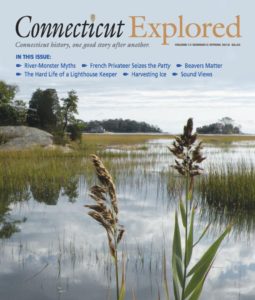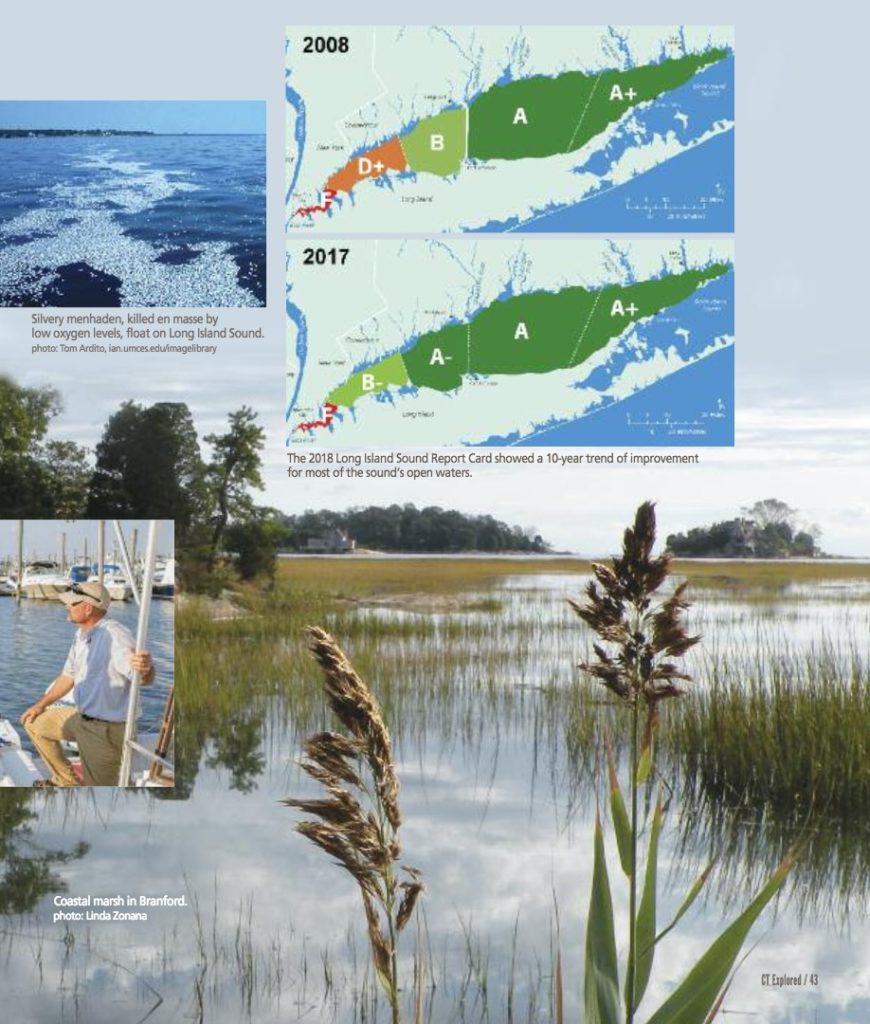By Bill Lucey
(c) Connecticut Explored Inc. Spring 2019
Subscribe/Buy the Issue
As the Soundkeeper, my job is to patrol Long Island Sound hunting for pollution. I frequently ask people I encounter what they think of the sound. Some refuse to go near it, fearing bacteria and toxins, while others freely swim, fish, and enjoy bluefish and oysters from its waters. I fall into the latter camp. Long Island Sound was my childhood paradise. My family, friends, and I collected shells, watched horseshoe crabs, and filled buckets with snapper blues and steamer clams. To understand these two very different ways of relating to the sound, we need to step back in time and take in its story.
The basin we now call Long Island Sound formed behind a bar of sediments and glacial deposits—Long Island—and began filling up after the last glacial period, reaching its current shoreline about 4,000 years ago. Along these shores and the long tidal river that feeds the sound, Native Americans grew and prospered, hunting elk, collecting shellfish, and fishing for sturgeon, herring, and salmon. Migratory shorebirds and waterfowl were watched by eagles perched along towering old-growth forests. In those early days the nutrient nitrogen was in limited supply, while tides brought in abundant phosphorous, feeding a shallow, prolific sea. Ocean-going fish brought marine nutrients up the rivers, rejuvenating the landscape.
The first known European vessel to enter the sound was Portuguese explorer Esteban Gomez’s in 1525. By then, Native communities were well established along the sound’s shores, with distinct language groups, villages, and agriculture. In the early 1600s trade networks grew rapidly, led by Adriaen Block’s efforts. But as an early warning of things to come, beaver were gone from Connecticut by the end of that century [See “Why We Need Beavers,” page 40]. Native peoples were soon decimated by European disease, and colonial America filled the landscape. Colonists erected thousands of dams on Connecticut’s streams to run grist and manufacturing mills, cutting off access to sea-run fish. And as forests fell to development, nitrogen flowing into the sound increased. As manufacturing grew, so did discharges of dyes, metals, and offal into the rivers, which transported these contaminants to the sound.
Over time the entire ecosystem was upended: nitrogen from the land became the primary nutrient instead of ocean-supplied phosphorous. It fueled overwhelming algal blooms. Vast die-offs of this plankton led to population explosions of anaerobic bacteria, driving out oxygen, and releasing toxic hydrogen sulfide. The loss of oxygen for extended periods, known as hypoxia, created huge fish kills. By the 1980s, fully a third of the sound was virtually asphyxiated each summer.
With alarm bells ringing, in stepped coalitions of fishermen, ecologists, governments, and private citizens beginning in earnest in the late 1980s. The original Soundkeeper, Terry Backer—himself a lobsterman—partnered with attorneys to wield citizen-action provisions of the Clean Water Act. He went after nitrogen- and bacteria-dumping sewage-treatment plants with zeal and documented thousands of Clean Water Act violations, leading to significant infrastructure upgrades. Today the Long Island Soundkeeper is part of Save the Sound and the Waterkeeper Alliance, still using on-the-water patrols to identify pollution hotspots and the Clean Water Act to get them fixed.
 Nonprofits, governments, and partnerships like the Long Island Sound Study now actively monitor oxygen, nitrogen, and bacteria levels in the sound. Regulations established and enforced by government and nonprofits like Save the Sound limit nitrogen from sewage plants, and outreach is targeting over-use of fertilizers and speeding adoption of new septic-tank technology. Save the Sound and partners are restoring coastal wetlands, building water-filtering rain gardens, and removing barriers to migratory fish. To monitor progress, a network of citizen scientists coordinated by Save the Sound now monitors water quality in 36 bays and harbors.
Nonprofits, governments, and partnerships like the Long Island Sound Study now actively monitor oxygen, nitrogen, and bacteria levels in the sound. Regulations established and enforced by government and nonprofits like Save the Sound limit nitrogen from sewage plants, and outreach is targeting over-use of fertilizers and speeding adoption of new septic-tank technology. Save the Sound and partners are restoring coastal wetlands, building water-filtering rain gardens, and removing barriers to migratory fish. To monitor progress, a network of citizen scientists coordinated by Save the Sound now monitors water quality in 36 bays and harbors.
The fall 2018 Long Island Sound Report Card describes a 10-year trend of improving water quality. As the waters warm and the watershed’s population continues to increase, new challenges will arise—but now the sound has a seasoned team in place to meet them.
Last October I was out patrolling near Bridgeport when an eagle swooped down, robbing an osprey of a menhaden chased to the surface by a striped bass. All four of these species were severely depleted by the 1980s, but all are returning to abundance through our collective efforts. It has taken years to get here, and will take more till we are done, but I truly believe together we can fully heal Long Island Sound and restore it to a place we all can trust and enjoy.
Bill Lucey is Soundkeeper for Connecticut Fund for the Environment/Save the Sound.

